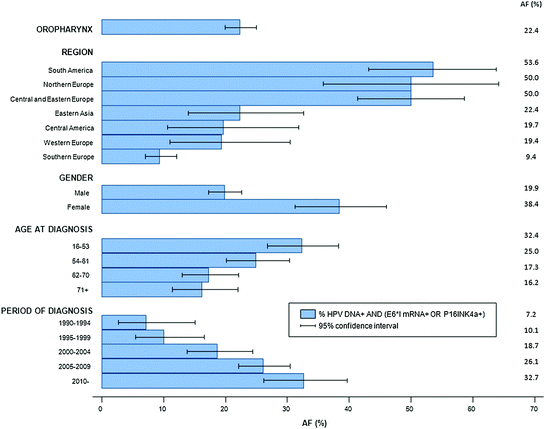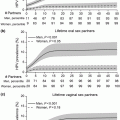Fig. 1
HPV-attributable fractions for head and neck cancers according to positivity and/or over-expression of selected biomarkers of HPV-induced carcinogenesis
Figure 2 shows oropharyngeal HPV-AFs by geography, gender, age group, and year of diagnosis. Estimates of HPV-AF in the oropharynx were highest in South America, Central and Eastern Europe and Northern Europe, and lowest in Southern Europe. Women showed higher HPV-AFs than men for cancers of the oropharynx. Globally, younger patients showed higher HPV-AFs than older patients and AFs tended to be higher in more recent decades with a statistically significant increasing trend in AFs with increasing recency.


Fig. 2
HPV-attributable fractions for oropharyngeal cancer according to world region, gender, age, and period of diagnosis
1.2 HPV-Type Distribution in HNCs
Among HPV-DNA-positive cancer cases, the distribution of individual HPV types is different in HNCs when compared with cervical cancers, as HPV16 is systematically found in a much higher percentage of HNCs than of cervical cancer. Confirming results from several other studies, the ICO study found that HPV16 is the most frequently detected genotype among HPV-DNA-positive cases (75.2 %), but again with a wide range according to cancer site: 83 % in the oropharynx, 68.8 % in the oral cavity, and 50.8 % in the larynx (Castellsagué et al. 2016). The corresponding percentages for combined HPV types included in the nonavalent HPV vaccine (types 6, 11, 16, 18, 31, 33, 45, 52, and 58) were 89.7, 76.3, and 81.4 %, indicating that most HPV-positive HNCs could eventually be prevented through HPV immunization programs.
2 Burden of HPV-Related HNCs
HNC is the seventh cause of incident cancer cases worldwide, with an estimated 686,328 new cases and 375,622 deaths every year (Ferlay et al. 2013). These estimations include the oral cavity, larynx, and pharynx (nasopharynx, oropharynx, and hypopharynx). Among HNCs, oral cavity (including lips) is the most common, representing more than 40 % of the cases. HNC shows a wide worldwide geographical heterogeneity in terms of incidence rates (Ferlay et al. 2013), likely reflecting a wide variability in the prevalence of established risk behaviors. Moreover, 75 % of the HNC burden occurs in men. As mentioned in the previous section, the association of HPV with HNC is also very heterogeneous with dramatic variations across anatomical sub-sites and geographical regions. The oropharynx is the sub-site with strongest associations with HPV. In some regions of the world such as USA or Northern Europe, more than 70 % of oropharyngeal cancer cases are estimated to be HPV-related (Chaturvedi et al. 2011), as compared with only 17 % in Southern Europe (De Martel et al. 2012).
However, as explained before, the mere use of HPV-DNA detection is not appropriate to classify a HNC as HPV-driven. Thus, the precise estimation of the burden of HPV-related HNCs requires the use of accurate HPV-AFs that include not only HPV-DNA detection but also at least one additional marker of HPV-induced carcinogenesis such as mRNA and/or p16 over-expression. The ICO survey is currently the largest and most robust study that used these markers in the definition of HPV-AFs in 3,680 HNC cases from Europe, Central and South America, Africa and Asia (Castellsagué et al. 2016). Based on sex- and region-specific HPV-AFs (as defined by HPV-DNA positivity and at least positivity by one additional marker, either mRNA or p16), we were able to estimate more accurately the burden of HPV-driven HNC in most world regions (Table 1). For regions not appropriately covered by the ICO study, global HPV-AFs from the ICO study or from other studies that tested for at least two HPV-related markers were used as indicated in the table footnotes. As shown in the table, we estimate that every year about 45,000 new HNC cases can be attributed to HPV infection worldwide. That table details the estimated burden by world region and sex for each major HNC site. It is important to mention that the HPV-AFs used in the ICO study might slightly underestimate the real number of HPV-driven HNCs because most HPV-DNA-negative samples were not tested for the additional markers and also because the assignment of HPV-driven cancers required positivity for at least two HPV-related markers.
Table 1
HPV-attributable fractions and estimated annual number of incident HNC cases attributable to HPV (requiring positivity for both HPV DNA and at least one additional HPV-related marker) by region, sex, and anatomical site
Oral cavitya | Oropharynxb | Larynxc | ALL SITES | ||||||||||||
|---|---|---|---|---|---|---|---|---|---|---|---|---|---|---|---|
Male | Female | Male | Female | Male | Female | Male | Female | All | |||||||
AFs (%) | HPV-driven N | AFs (%) | HPV-driven N | AFs (%) | HPV-driven N | AFs (%) | HPV-driven N | AFs (%) | HPV-driven N | AFs (%) | HPV-driven N | HPV-driven N | HPV-driven N | HPV-driven N | |
Europe | 4.4d | 1,873 | 2.6d | 490 | 16.9d | 3,753 | 40.2d | 1,792 | 2.2d | 792 | 4.3d | 169 | 6,418 | 2,451 | 8,869 |
Asia | 4.7e | 5,264 | 3.8e | 2,161 | 18.8d | 6,619 | 17.6d | 1,429 | 2.8e | 1,925 | 9.2e | 805 | 13,808 | 4,395 | 18,203 |
North America | 8.9f | 1,683 | 1.7f | 164 | 71.2 g | 6,551 | 55.2 g | 1,334 | 2.8e | 300 | 9.2e | 254 | 8,534 | 1,752 | 10,286 |
Central-South America | 6.4d | 831 | 6.8d | 520 | 37.8d | 1,919 | 51.6d | 629 | 4.8d | 686 | 15.6d | 343 | 3,436 | 1,492 | 4,928 |
Africa | 4.7e | 281 | 3.8e | 268 | 19.9e | 511 | 38.4e
Stay updated, free articles. Join our Telegram channel
Full access? Get Clinical Tree
 Get Clinical Tree app for offline access
Get Clinical Tree app for offline access

| ||||||||



